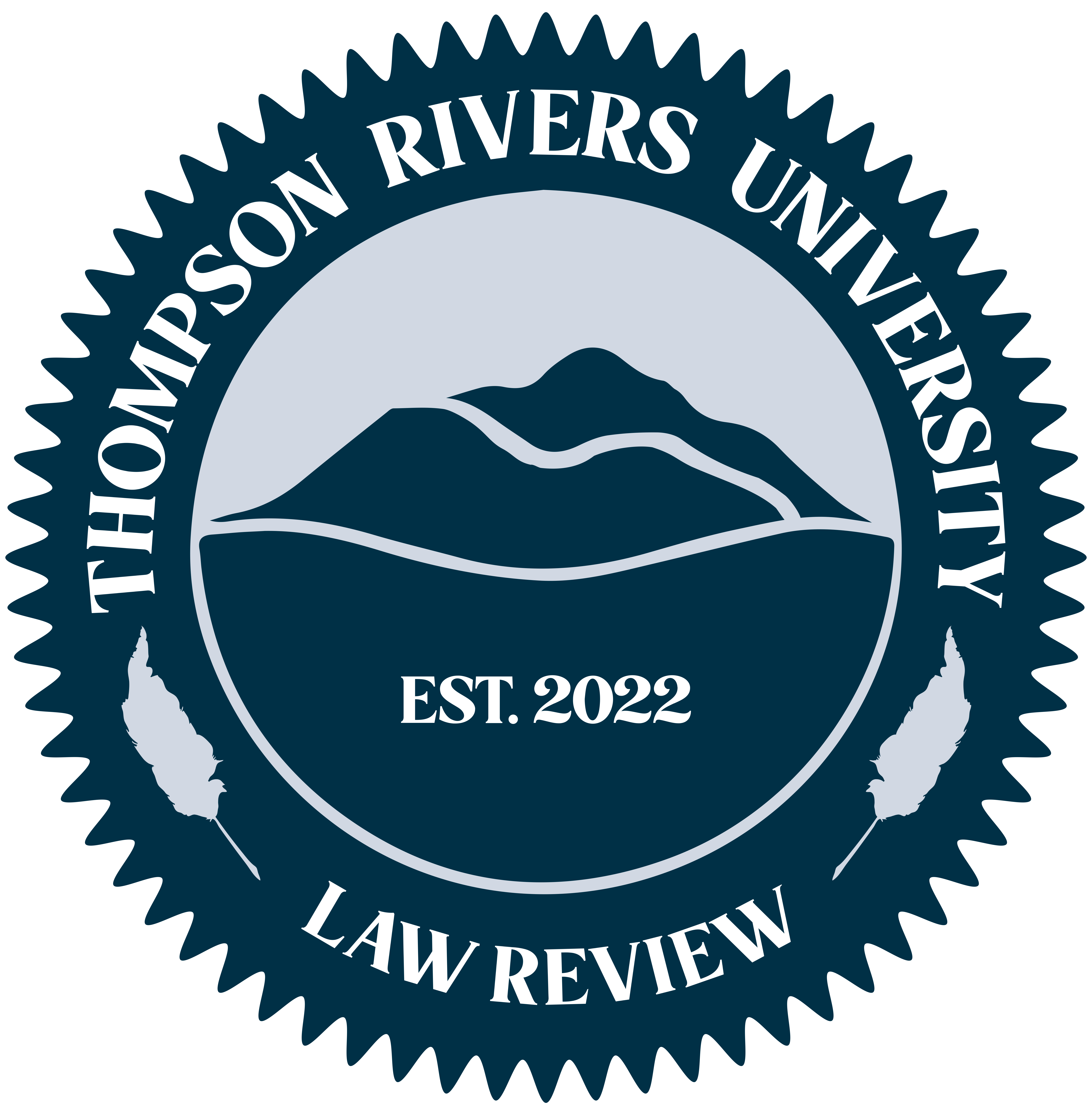Editorial Process
The editing process from initial receipt of manuscript to publication will approximate the procedure outlined here.
The Editor-in-Chief (Editorial) controls this process and employs discretion with an eye to achieving the aims of the Thompson Rivers University Law Review (“TRU Law Review”) and enhancing its professional reputation.
The Editor-in-Chief manages the editing process with the goal that accepted manuscripts will be published electronically as swiftly as possible. Manuscripts can usually be published within 16 weeks of initial receipt if accepted for publication.
The review process slows during the Faculty of Law’s examination periods in April and December.
The editing process is subject to revision without notice.
Step 1:
Receipt of Manuscript
The TRU Law Review’s website provides the submission guidelines and instructions for authors. A designated student editor will receive manuscripts electronically and assess them for compliance with the guidelines.
Step 2:
Anonymization of Manuscript
A designated student editor will anonymize each manuscript prior to the initial review of its content. The purpose of anonymizing submissions is to ensure that manuscripts are assessed solely for their content against fair, objective criteria. The designated student editor will be the only editor aware of an author’s identity until a final decision is rendered in respect of whether to publish the submission. Prior to the next stage of the process, the designated student editor will read through each manuscript and redact anything which identifies its author.
Step 3:
First Review of Content
The Editor-in-Chief will form a committee to review the manuscript. The committee will assess the manuscript for whether it is suitable for publication (potentially with major, small, or no revisions) or unfit for publication altogether. This committee will include at least one Faculty Advisor who will assess the academic quality of the manuscript. If there is a reasonable chance of publication, the manuscript will proceed to the next stage of evaluation. Otherwise, the committee may reject a manuscript at this stage.
To be suitable for publication, a manuscript should demonstrate impressive legal research and writing, careful investigation of its thesis, clarity, and logical coherence. Above all, the manuscript must provide something of worth to the legal landscape. This might include a new idea or a synthesis of ideas.
Step 4:
Blind Peer Review
The manuscript will then undergo a blind peer review process. This means that the reviewing peer(s) will not learn the identity of the author and the author will not learn the identity of the reviewing peer(s).
The committee will locate and engage one or two Canadian scholars familiar with the subject of the manuscript for peer review. The committee will negotiate and establish a reasonable timeframe for peer review, noting the ultimate 16-week goal.
The committee will receive comments from the peer reviewer(s). The committee will consider these comments and determine whether the manuscript is suitable to proceed to the next stage of the editing process. Otherwise, the committee may reject the manuscript at this stage.
Step 5:
Focused Analysis of Content
The Editor-in-Chief will form a committee to critically analyze the manuscript’s content. The committee will prepare notes for the author at this stage. The notes may recommend revisions to the manuscript, major or small. The notes will convey the comments of the peer reviewers as well as other comments in respect of the manuscript’s writing, accuracy, comprehensiveness, and/or overall argument. The notes will be constructive; they will assist the author with making the revisions necessary to bring the piece one step closer to publication.
The committee will send a letter to the author detailing the proposed amendments. The author will be provided with a reasonable timeframe to make improvements.
The committee may reject the manuscript at this stage.
Step 6:
Review of Resubmitted Manuscript
Once an author has submitted their article with amendments, the committee will review the revised manuscript to assess for quality and suitability for publication. The committee may recommend further revisions to the author and provide a new timeframe to make improvements.
The committee may reject the manuscript at this stage.
Step 7:
Light Edits and Citation Checks
Once an author has provided a manuscript that is ready for final edits, the Editor-in-Chief will assign editors for a line-edit and citation check.
At this stage, the assigned editors will bring the manuscript’s writing to perfection in terms of grammar and style. They will refer to the most recent edition of The Chicago Manual of Style (available here) for guidance on grammar, style, and usage. The TRU Law Review aims to be flexible in its approach to style as this is more inclusive and responsive to societal changes. Editors may deviate from the conventions of style if they would result in awkward text.
Student editors will edit with a light hand. They will aim not to disrupt or diminish the author’s voice and writing style. Instead, they will endeavour to provide edits which will accentuate the author’s ideas. Edits will be made using ‘track changes’ so that the author can assess the suggested revisions.
The editors will review each citation for accuracy and to ensure the referenced sources provide the information on which the author relies. The editors will ensure each footnote complies with the most recent edition of the Oxford University Standard for the Citation of Legal Authorities.
Step 8:
Final Review by Editor-in-Chief
The Editor-in-Chief (Editorial) will conduct a final review of the manuscript before it is finalized for publication.
Step 9:
Formatting and Publication
The manuscript will be finalized at this stage. The formatting and layout will be adjusted to meet the TRU Law Review style. The article will be published on the TRU Law Review’s website.
Once the journal has established a publishing record, it will be indexed and featured in popular research databases and search engines. The TRU Law Review will aim to disseminate its published content to reputable platforms in accordance with its open-access policy.
